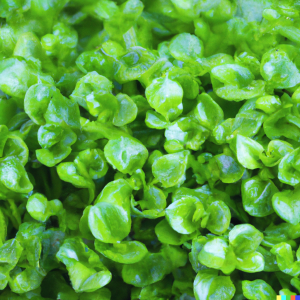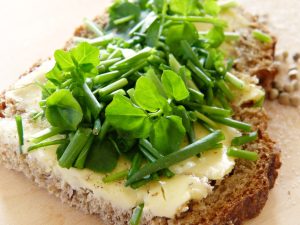
Watercress is an often overlooked, yet incredibly nutritious and versatile leafy green vegetable. It has been consumed for centuries, but in recent years has been slowly making a comeback as a health-conscious ingredient in salads, sandwiches and smoothies. With its unique peppery flavor, crunchy texture and high antioxidant content, watercress is a powerhouse in the kitchen.
Watercress is a member of the Brassicaceae family, which also includes broccoli, cabbage, kale and arugula. It is an annual herb that grows best in shallow, flowing water. It has a round stem and small, dark green leaves that are sharply serrated. It has a unique peppery taste that is similar to the taste of radish, horseradish and mustard.
Nutritional Benefits of Watercress
Watercress is a leafy green vegetable that is packed with essential vitamins and minerals that can be beneficial to human health. It is also a low-calorie food that is low in fat, cholesterol, and sodium, making it an ideal choice for those looking to improve their overall nutritional intake.
Watercress is high in many essential vitamins and minerals, including vitamin A, vitamin C, vitamin K, calcium, iron, and magnesium. Vitamin A is important for healthy vision, while vitamin C helps to boost the immune system and protect against cell damage. Vitamin K is essential for proper blood clotting and bone health, while calcium helps to build and maintain strong bones and teeth. Iron is important for red blood cell production, and magnesium is essential for energy production and nerve and muscle function.
Watercress is also a great source of dietary fiber, which is important for digestive health. Dietary fiber has been linked to a reduced risk of heart disease, diabetes, and certain types of cancer. It can help reduce cholesterol levels, maintain regular bowel movements, and help control blood sugar levels. For those looking to lose weight, watercress can be beneficial as it is low in calories and high in dietary fiber – both of which can help you feel fuller for longer, making it easier to stay on track with your weight loss goals.
Watercress is also an excellent source of antioxidants, which are compounds that help protect our cells from damage caused by free radicals. Free radicals are molecules that can damage our cells, leading to conditions such as heart disease, diabetes, and certain types of cancer. Antioxidants help protect our cells from this damage by neutralizing the free radicals, which can help reduce the risk of these conditions.
Watercress is a great source of essential fatty acids, including omega-3 fatty acids. Omega-3 fatty acids are important for heart health and can help reduce inflammation in the body, as well as lower cholesterol levels. They can also help reduce the risk of certain types of cancer, improve brain function, and reduce the risk of depression.
History of Watercress
The earliest record of watercress is from ancient Egypt, where it was used as a medicinal herb. This is supported by various drawings and paintings from this period depicting people gathering watercress from the Nile.
Watercress is believed to have been first cultivated in the Mediterranean region around 53-79 AD during the Roman Empire. It was used in many dishes, including salads and soups, and it was also highly valued for its medicinal properties. It was believed to improve digestion and help with kidney problems. Watercress was also used to treat skin ailments, such as acne and eczema.
During the Middle Ages, watercress was used as a refreshing beverage, and it was also used to treat scurvy. During this time, watercress was also believed to have magical powers and was used to ward off evil spirits. It was also used as a form of currency in some areas.
In England, watercress was first grown around 1650 and was used as a garnish for dishes. The plants were grown in beds and kept wet by flooding the beds with water channeled from nearby rivers. In the 1700s, watercress became popular in England and was enjoyed as a salad ingredient.
In the early 1800s, watercress began to be cultivated on a larger scale. It was grown in beds and also in shallow tanks of running water to keep the plants healthy and growing. In some areas, the watercress was grown in man-made ponds.
By the mid 1800s, watercress was being exported from England to other countries. In the US, the plant was mainly grown in California, with some small-scale cultivation in other states. Watercress was sold at markets and was used as a garnish for dishes.
In the late 1800s and early 1900s, watercress became more widely available in the US and was used as an ingredient in salads and soups. It was also eaten on its own as a snack. In the UK, watercress was used in sandwiches and was commonly referred to as “cress sandwiches”.
Today, watercress is still enjoyed as a culinary and medicinal herb. It is widely available in supermarkets and is often sold in bunches.
Cooking with Watercress

Cooking with watercress is an underrated and often overlooked culinary delight. Not only is it a healthy and nutritious ingredient, it adds an unexpected taste and texture to dishes. Its slightly bitter taste and crunch make it an ideal addition to a variety of dishes, from salads and soups to sandwiches and omelets.
One of the great things about watercress is that it is incredibly versatile in the kitchen. It can be used raw in salads and sandwiches, or cooked into soups, omelets, and stir-fries. It is important to note that watercress does not require long cooking times, so it’s best to add it at the end of a dish’s cooking time or shortly before serving.
When it comes to salads, watercress makes a great addition to any mix of greens. It adds a slightly bitter kick to the dish, and its texture is nice and crunchy. It can also be added to sandwiches, wraps, and tacos to provide a unique flavor and texture.
Watercress is also great in soups and stews, as it adds a unique flavor and texture. It is best to add it near the end of the cooking time to ensure it does not become overly soft. Watercress can also be used in omelets, stir-fries, and frittatas. Again, it is important to add it at the end of the cooking time to ensure it retains its crunch.
Watercress pairs especially well with nutty flavors, like that of walnuts and hazelnuts. It’s also great when cooked with garlic and onions, as the flavor of these ingredients balance out the bitterness of the watercress.
Clinical Studies on Watercress
One of the most notable studies on watercress was published in the British Journal of Nutrition in 2008. This study found that consuming watercress may help to reduce the risk of developing breast cancer. Women who consumed 85 grams of watercress per day for eight weeks saw a significant decrease in biomarkers associated with breast cancer. This is particularly exciting news for those at a higher risk of breast cancer or for those looking for natural ways to support breast health.
Another study, published in the journal Cancer Epidemiology, Biomarkers & Prevention in 2009, discovered that watercress may also be beneficial in reducing the risk of prostate cancer. Men who consumed significant amounts of watercress per day for eight weeks had significantly lower levels of biomarkers associated with prostate cancer.
But the benefits of watercress don’t stop there. In a 2013 study, published in the Journal of Inflammation, it was found that consuming watercress may help to reduce inflammation and improve overall health. The study participants who consumed watercress every day for four weeks saw a significant decrease in inflammatory markers and an improvement in antioxidant status. This can have far-reaching effects on overall health, including reducing the risk of chronic diseases.
It’s important to note that more research is needed to fully understand the effects of watercress on human health. However, these studies provide a glimpse into the potential benefits that watercress can offer. So, next time you’re at the grocery store or farmer’s market, don’t overlook this leafy green vegetable.